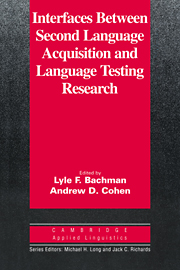Book contents
- Frontmatter
- Contents
- List of contributors
- Series editors' preface
- Preface
- Chapter 1 Language testing – SLA interfaces: An update
- Chapter 2 Construct definition and validity inquiry in SLA research
- Chapter 3 Research on interlanguage variation: Implications for language testing
- Chapter 4 Strategies and processes in test taking and SLA
- Chapter 5 Describing language development? Rating scales and SLA
- Chapter 6 Testing methods in context-based second language research
- Chapter 7 How can language testing and SLA benefit from each other? The case of discourse
- Appendix: Language testing – SLA research interfaces
- Index
Chapter 4 - Strategies and processes in test taking and SLA
Published online by Cambridge University Press: 05 October 2012
- Frontmatter
- Contents
- List of contributors
- Series editors' preface
- Preface
- Chapter 1 Language testing – SLA interfaces: An update
- Chapter 2 Construct definition and validity inquiry in SLA research
- Chapter 3 Research on interlanguage variation: Implications for language testing
- Chapter 4 Strategies and processes in test taking and SLA
- Chapter 5 Describing language development? Rating scales and SLA
- Chapter 6 Testing methods in context-based second language research
- Chapter 7 How can language testing and SLA benefit from each other? The case of discourse
- Appendix: Language testing – SLA research interfaces
- Index
Summary
A process approach to test taking
One of first requests that more attention be paid to the processes of respondents in giving answers on language tests was issued by Bormuth (1970):
There are no studies, known to the author, which have attempted to analyze the strategies students use to derive correct answers to a class of items. The custom has been to accept the test author's claims about what underlying processes were tested by an item. And, since there were no operational methods for defining classes of items, it was not scientifically very useful to present empirical challenges to the test author's claims,
(p. 72)Bormuth's book outlines the objectives and major components of a theory for writing items for achievement tests, drawing on structural linguistics, semantics, and logic. Subsequently, studies began to appear that entailed observation and description of how learners at different age levels actually accomplish first language (LI) testing tasks. For example, with respect to a teacher's oral questioning of young children, it has been suggested that “the interrogator and respondent work together to jointly compose the ‘social fact’ we call an answer-to-a-question” (Mehan 1974: 44). On the basis of his research efforts, Mehan indicated that it may be misguided to conclude “that a wrong answer is due to a lack of understanding, for the answer may come from an alternative, equally valid interpretation.”
- Type
- Chapter
- Information
- Publisher: Cambridge University PressPrint publication year: 1999
- 8
- Cited by



